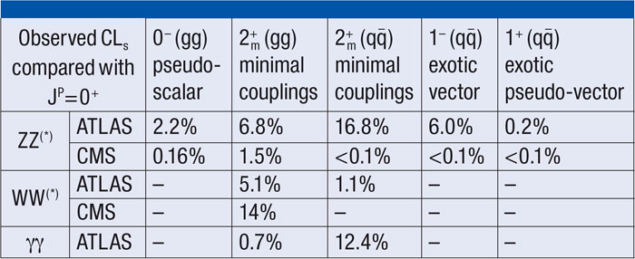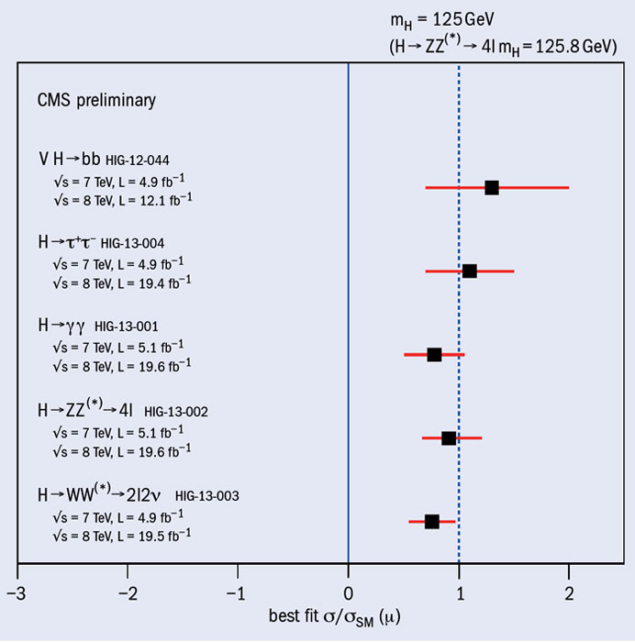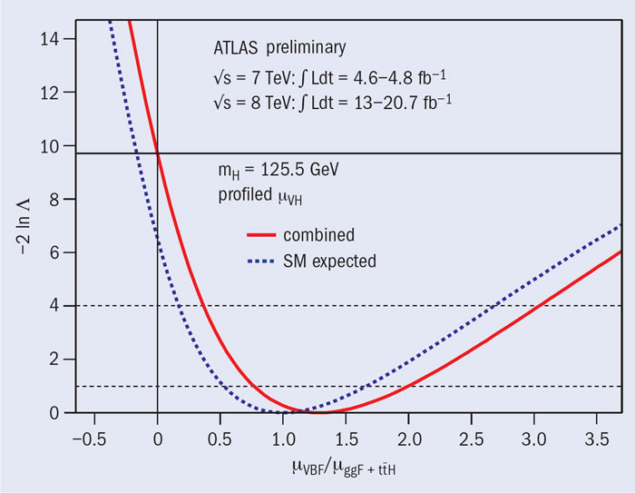How the new particle of 2012 has this year acquired a name.

In the history of particle physics, July 2012 will feature prominently as the date when the ATLAS and CMS collaborations announced that they had discovered a new particle with a mass near 125 GeV in studies of proton–proton collisions at the LHC. The discovery followed just over a year of dedicated searches for the Higgs boson, the particle linked to the Brout-Englert-Higgs mechanism that endows elementary particles with mass. At this early stage, the phrase “Higgs-like boson” was the recognized shorthand for a boson whose properties were yet to be fully investigated. The outstanding performance of the LHC in the second half of 2012 delivered four times as much data at 8 TeV in the centre of mass as were used in the “discovery” analyses. Thus equipped, the experiments were able to present new results at the 2013 Rencontres de Moriond in March, giving the particle-physics community enough evidence to name this new boson “a Higgs boson”.
At the Moriond meeting, in addition to a suite of final results from the experiments at Fermilab’s Tevatron on the same subject, the ATLAS and CMS collaborations presented preliminary new results that further elucidate the nature of the particle discovered just eight months earlier. The collaborations find that the new particle is looking more and more like a Higgs boson. However, it remains an open question whether this is the Higgs boson of the Standard Model of particle physics, or one of several such bosons predicted in theories that go beyond the Standard Model. Finding the answer to this question will require more time and data.

This brief summary provides an update of the measurements of the properties of the newly discovered boson using, in most cases, the full proton–proton collision data sample recorded by the ATLAS and CMS experiments in 2011 and 2012 for the H→γγ, H→ZZ(*)→4l, H→WW(*)→lνlν, H→τ+τ– and H→bb channels, corresponding to integrated luminosities of up to 5 fb–1 at √s = 7 TeV and up to 21 fb–1 at √s = 8 TeV. In the intervening time, CMS and ATLAS have also developed searches for rarer decays – such as H→Zγ or H→μ+μ– – and for invisible or undetectable decays expected in theories beyond the Standard Model.

Whether or not the new particle is a Higgs boson is demonstrated by how it interacts with other particles, as well as by its own quantum properties. For example, a Higgs boson is postulated to have no spin and in the Standard Model its parity – a measure of how its mirror image behaves – should be positive. ATLAS and CMS have compared a number of alternative spin-parity (JP) assignments for this particle and, in pairwise hypothesis tests, the hypothesis of zero spin and positive parity (0+) is consistently favoured, as summarized in Table 1.
In CMS, the presence of a signal has been established in each of several expected decay channels. The H→γγ and H→ZZ(*)→4l channels point to a mass between 125.4 GeV and 125.8 GeV. For mH = 125 GeV, an excess of 4.1σ is observed in the H→WW(*)→lνlν channel and there are remarkable positive results in the decays to b quarks (2.2σ) and τ leptons (2.9σ), an important hint that this Higgs boson also couples to fermions. As expected in the Standard Model, the search for H→Zγ has not yielded a signal – nevertheless constraining the possibilities of models beyond the Standard Model.
Apart from exploiting the larger set of 8 TeV data, the CMS analyses have benefited from many improvements since the discovery announcement, from revised calibration constants to more sensitive analysis methods. In the H→γγ and H→ZZ(*)→4l channels, the largest difference is in the use of event classes with specific topologies to exploit the associated production modes. In these channels, the mass measurement has also benefited from improved energy and momentum resolution. Figure 1 shows the data entering the H→ZZ(*)→4l analysis and it gives a sense of how individual events build up to a 6.7σ excess of events and how their mass resolution (also depicted) allows a measurement of the mass of the new boson at 125.8 ± 0.5(stat.) ± 0.2(syst.) GeV, the precision being dominated by statistics and already better than 0.5%. This mass measurement is in remarkable agreement with the value of 125.4 ± 0.5(stat.) ± 0.6(syst.) GeV measured in the H→γγ channel, where the excess has a significance of 3.2σ. Updated CMS analysis of H→γγ, which takes advantage of the improved detector calibration, yields a result close to that expected for the Standard Model Higgs boson in terms of signal strength, μ = σ/σSM = 0.78+0.28–0.26

In figure 2, an overview of the main decays studied in CMS shows how evidence for a Higgs boson can be seen in each channel with individual significances ranging from 2.2σ to 6.7σ. With respect to the results presented by CMS last July, there are slight differences in the individual signal strengths: smaller in the H→γγ channel and larger in the H→bb and H→τ+τ– channels. These results strongly indicate that it is a Higgs boson. Overall, the results continue to be fully compatible with the expectation for a Standard Model Higgs boson, while within the current uncertainties many scenarios of physics beyond the Standard Model are still allowed.
For ATLAS, the combined signal strength for H→γγ, H→ZZ(*)→4l, H→WW(*)→lνlν and H→τ+τ– has been determined to be μ = 1.30 ± 0.13(stat.) ± 0.14(syst.) at the new mass measurement of 125.5 ± 0.2(stat.)+0.5–0.6(syst.) GeV. The collaboration has also measured the ratio of the cross-sections for vector-boson mediated and (predominantly) gluon-initiated processes for producing a Higgs boson, as shown in figure 3. Measurements of relative branching-fraction ratios between the H→γγ, H→ZZ(*)→4l and H→WW(*)→lνlν channels, as well as combined fits testing the fermion and vector coupling sector, couplings to W and Z and loop-induced processes of the Higgs-like boson, show no significant deviation from the Standard Model expectation, as figure 4 shows.
Figure 3 compares a summary of the combined results for Higgs production to the Standard Model expectation and demonstrates an overall consistency. Here, a common signal-strength scale factor, ggF+ttH, has been assigned to the gluon-fusion (ggF) and the small ttH production mode because they both scale predominantly with the Yukawa coupling of the top quark in the Standard Model. For the combination, vector-boson-fusion-like events and gluon-fusion-like events are distinguished within the individual analyses based on the kinematic properties of the event. The combined measured ratio of production scaling factors, μVBF/μggF+ttH = 1.2+0.7–0.5, driven by the H→γγ channel measurement, gives more than 3σ evidence for Higgs-boson production through vector-boson fusion.

Having demonstrated overall consistency in terms of production, five tests of the observed coupling scale factors are summarized in figure 4. This shows the overall consistency with the Standard Model hypothesis and places limits on various model extensions for the produced Higgs boson. These tests are implemented according to recommendations from the Higgs Cross-Section Working Group. The ATLAS results assume a single, narrow CP-even Higgs resonance at mH = 125.5 GeV with coupling strengths that may depart from the Standard Model in various prescribed ways. For example, the relative vector boson and fermion coupling strengths (labelled κV, κF) are allowed to vary, giving the experimental constraints on the relative deviation of these quantities shown in the upper section of figure 4. The current results are not powerful enough to resolve the ambiguity in the relative sign of κV and κF. Considering κV > 0, κF has a double minimum leading to the observed structure in the intervals allowed by the data. Figure 4 also shows the results for other benchmark parameterizations where no assumption is made on the total width for the fermion-to-boson coupling-strength ratio (labelled λFV) and where the ratio of W-to-Z couplings is tested (labelled λWZ). Scenarios for physics beyond the Standard Model contributions via loops (labelled κg, κγ) and via invisible or undetectable decays (labelled Bi,u) can similarly be compared with the intervals allowed by the data.
Using the latest data, alternative hypotheses have been tested but none of them is found to be preferred over the Standard Model.
After eight months, and thanks to the extraordinary performance of the LHC, the ATLAS and CMS collaborations have revealed more of the true nature of a new boson that is unique in the Standard Model. The more detailed picture that ATLAS and CMS have put together on this newborn boson since July 2012 remains unfailingly consistent with expectations drawn from the Standard Model, with the spin, parity, relative couplings, production and decay mechanisms all consistent at the current level of precision. Using the latest data, alternative hypotheses have been tested but none of them is found to be preferred over the Standard Model; rare decays have been searched for but, as expected in the Standard Model, no evidence for a signal has been found. The more similar this Higgs boson is to the Standard Model expectation, the more time, data and ingenuity will be required in the analyses of the LHC data to provide hints of physics at work beyond the Standard Model. Ultimately, upgraded and new accelerators will be needed to understand the interactions of the Higgs boson at a deeper level but for now it is clear that this boson is a precious thread with which we can hope to unravel more of the remaining mysteries of the universe.









1 Comment